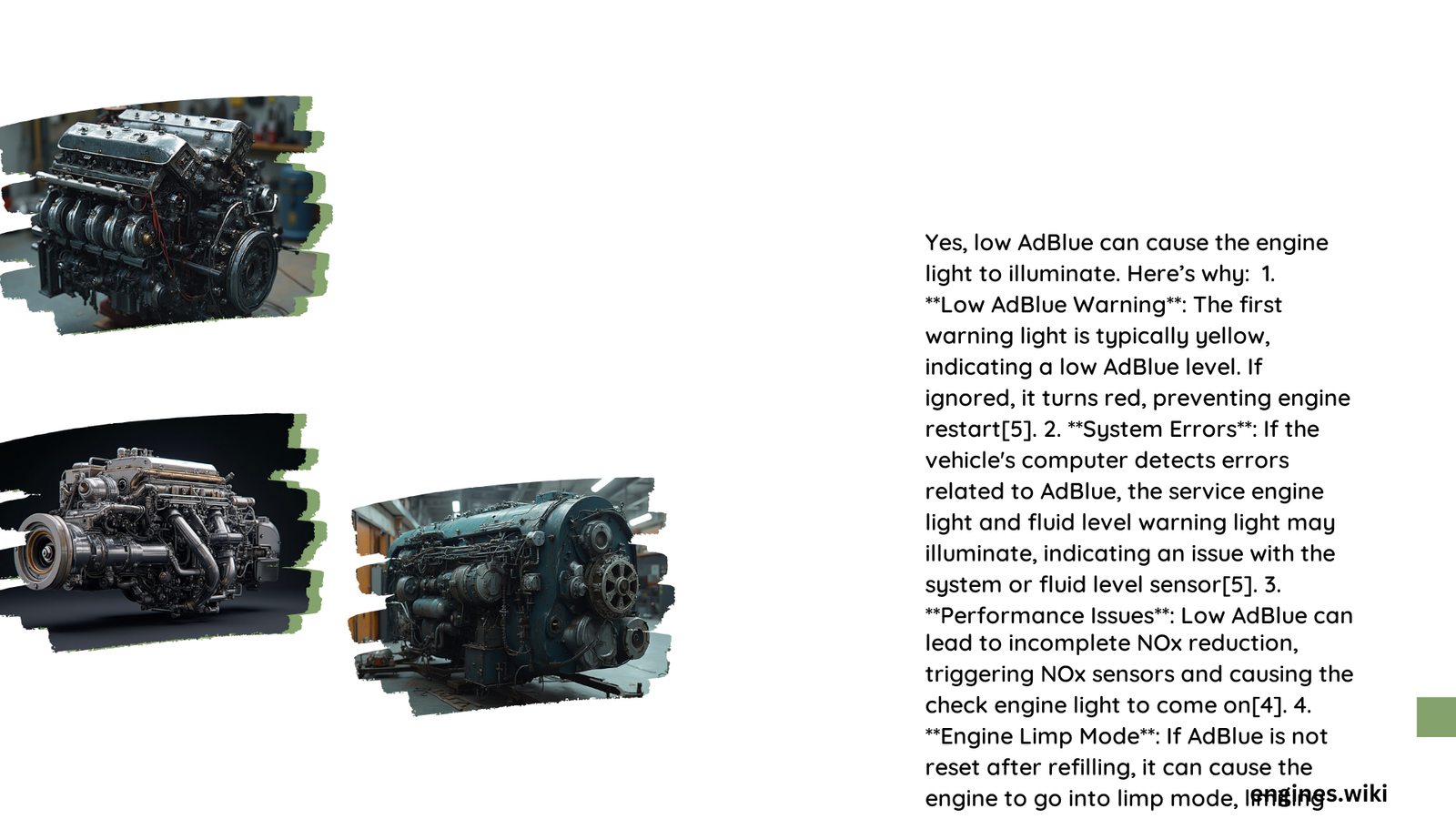Low AdBlue levels can indeed cause engine warning lights to illuminate, signaling potential emission system problems. When AdBlue fluid drops below critical thresholds, modern diesel vehicles activate warning indicators, restrict engine performance, and potentially prevent vehicle operation to protect the selective catalytic reduction (SCR) system and prevent excessive nitrogen oxide emissions.
What Happens When AdBlue Levels Drop?
Can Low AdBlue Trigger Engine Warning Lights?
Yes, low AdBlue levels can directly cause engine warning lights to activate. The vehicle’s onboard computer continuously monitors the selective catalytic reduction (SCR) system, and when AdBlue fluid falls below specific thresholds, it triggers warning indicators to alert the driver.
Warning Light Progression
| AdBlue Level | Warning Indicator | Vehicle Response |
|---|---|---|
| 1,500 miles remaining | Initial soft warning | No performance restrictions |
| 1,000 miles remaining | Amber warning | Increased frequency of alerts |
| Critical low level | Red warning | Engine power reduction |
| Completely empty | Complete shutdown | Vehicle cannot restart |
What Causes AdBlue Warning Lights?
Several factors contribute to AdBlue warning lights:
- Insufficient Fluid Levels
- Depleted AdBlue tank
- Slow fluid consumption
-
Lack of regular maintenance
-
System Sensor Malfunction
- Faulty AdBlue level sensor
- Electrical connection issues
-
Contaminated fluid
-
SCR System Complications
- Blocked injection nozzles
- Temperature sensor problems
- Pump dysfunction
How Do Engine Codes Relate to Low AdBlue?
Specific diagnostic trouble codes (DTCs) indicate AdBlue-related issues:
- P20EE: Indicates low DEF (Diesel Exhaust Fluid) levels
- P20EF: Signals DEF system malfunction
- P20F0: Suggests DEF tank temperature sensor circuit problem
What Are Potential Consequences of Ignoring AdBlue Warnings?
Neglecting AdBlue warnings can lead to significant vehicle complications:
- Performance Limitations
- Reduced engine power
- Speed restrictions
-
Potential “limp home” mode activation
-
Financial Implications
- Increased repair costs
- Potential warranty invalidation
- Higher emissions-related penalties
How to Address Low AdBlue Warnings?
Recommended Action Steps
- Check current AdBlue fluid level
- Refill AdBlue to manufacturer-recommended quantity
- Use high-quality, manufacturer-approved AdBlue
- Reset vehicle’s warning system
- Perform diagnostic scan to verify system functionality
What Is the Typical AdBlue Consumption Rate?
Most diesel vehicles consume AdBlue at approximately:
– 1-2 liters per 620-930 miles
– Varies based on vehicle model
– Driving conditions impact consumption rate
Expert Maintenance Tips
- Regular Monitoring
- Check AdBlue levels during routine maintenance
- Don’t wait for warning lights
-
Keep fluid topped up proactively
-
Quality Matters
- Use only certified AdBlue
- Avoid contamination
- Store in recommended conditions
Technical Insights
AdBlue, or diesel exhaust fluid (DEF), is a critical component in modern diesel emission control systems. Composed of 32.5% urea and 67.5% deionized water, it helps convert harmful nitrogen oxide emissions into harmless nitrogen and water.
Conclusion

Understanding the relationship between low AdBlue and engine warning lights is crucial for maintaining your diesel vehicle’s performance and longevity. Proactive monitoring, timely refills, and professional diagnostics can prevent costly repairs and ensure optimal engine efficiency.
